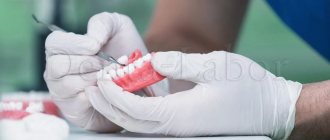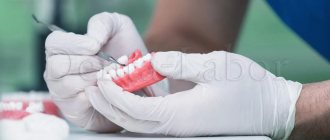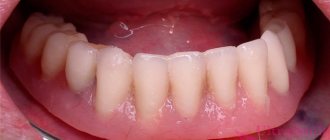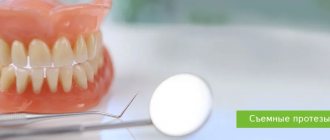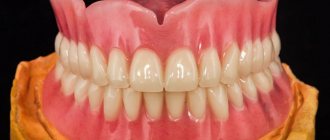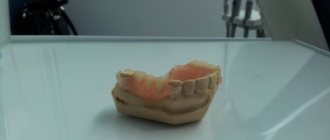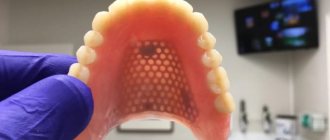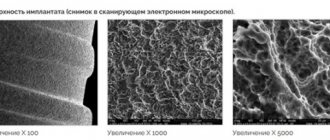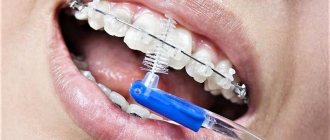According to statistics, in the first year of use, about 13–15% of prosthetic structures made of acrylic and 8–10% of modern thermoplastic materials break. Unfortunately, breakdowns always happen, as circumstances vary. Damage can be caused by injury, excessive load, or improper care of the structure. Many patients who are faced with this situation are interested in whether it is possible to glue a denture and how to do it.
Indications and contraindications
Welding an artificial tooth to a removable orthopedic structure allows you to restore its functionality. The procedure is carried out:
- during extraction or complete destruction of an abutment tooth,
- damage or breakage of an artificial tooth due to high chewing loads,
- loss of a prosthetic element from the base.
You cannot weld an artificial tooth if the base of the prosthesis is severely damaged. Another contraindication is significant atrophy of bone tissue due to prolonged wearing of a removable structure. In such cases, a new prosthesis may be recommended.
First steps in the event of a broken orthopedic structure
If the base part is broken, do not try to glue it together yourself. There are many “advisers” on the Internet, but it is not advisable to follow unprofessional recommendations. Otherwise, you may miss the opportunity to repair the product and permanently damage it. And then you will have to order a new prosthesis.
Therefore, first of all, contact the clinic where you installed this structure. An orthopedic dentist will provide you with professional assistance in this situation. At the reception specialist:
- inspect the damaged structure;
- will evaluate the possibility of repairing it;
- will inform you about further actions.
If the module is repairable, it will be sent to a dental laboratory. In just a couple of days, the integrity of the prosthetic system will be restored. If the warranty period has not expired, repairs are made free of charge.
It is not always possible to repair the base part; for example, it is almost impossible to repair old nylon dentures that are more than two years old. In this case, you will be offered the manufacture of a new product.
Methodology
To weld a tooth to a removable denture, perform the following steps:
- an impression of the jaw in the prosthesis is taken along with an impression of the teeth on the opposite side,
- a plaster model is made based on the casts obtained,
- produce and install missing artificial elements,
- grind and polish the prosthesis.
The time required for welding a tooth to a removable denture depends on the complexity of the work and the number of damaged structural elements. On average, a simple repair takes from 1 to 5 hours. In complex cases, the dental technician may need more time.
After making the prosthesis, the dentist tries it on and corrects it. The patient is given recommendations for caring for the structure and a date is set for the next visit.
Independent restoration of the prosthetic structure
You can try to solve the problem on your own only when it is not possible to see a dentist in the near future. For example, if a crown falls out, you can temporarily fix it in the base using special adhesive for dentures. Action plan:
- First, thoroughly clean the separated parts of the structure and dry thoroughly.
- Then apply adhesive to the crown and place it in place.
- After this, put on the denture, clench your jaws and wait a minute until the glue sets.
- Refrain from eating or drinking for the next 45 minutes.
It will not be possible to restore the structure in this way for a long time, but time can be gained. Later, it is still worth visiting a dental clinic and taking the product for professional repair.
Some patients try to fix the crowns in the prosthesis base with superglue. But this method is hazardous to health due to the toxic composition of the adhesive. After using it, you can get poisoned or have a severe allergic reaction. In addition, superglue will also solve the problem for a short time, since it is not intended for these purposes. After its use, the prosthesis may break completely, and it will most likely not be possible to restore it.
Rules for caring for a restored prosthesis
In order for the prosthesis to last as long as possible after repair, you need to follow a number of rules:
- carry out oral hygiene regularly,
- After each meal, rinse the removable denture with running water,
- store the structure in water or disinfectant liquid,
- do not wash the denture with hot water,
- Do not use pastes with large abrasive particles to brush your teeth.
It is important for patients to carefully monitor the condition of the prosthesis, handle it carefully and not drop it. In case of chips or other damage to artificial teeth, you should not try to solve the problem yourself. Structural repairs can only be trusted to experienced specialists. Before restoration, consultation with an orthopedic dentist is necessary.
Repairing a prosthesis by welding a tooth (clasp) in Moscow
Removable dentures are an excellent option for restoring the integrity of the dentition. This product is distinguished by its high degree of reliability, affordable price, comfort of use and ease of maintenance. Alas, when worn for a long time or under the influence of any harmful factors, certain parts of the prosthesis can wear down and break. If a prosthesis breaks, it must be urgently repaired. One type of prosthesis repair is repairing a prosthesis with welding of a tooth (clasp).
Indications for repairing a prosthesis by welding a tooth.
Welding an artificial tooth to a removable denture makes it possible to restore its functionality. Repair of a prosthesis by welding is carried out when:
- extraction or total destruction of the abutment tooth;v
- malfunction or breakage of an artificial tooth due to heavy stress while chewing food;
- loss of part of the removable denture from the base.
Contraindications for welding a tooth to a removable denture
- the base of the prosthesis is severely damaged;
- quite high bone tissue atrophy due to long-term use of the prosthesis. In this situation, it is recommended to make a new removable denture.
Stages of repairing a removable denture with welding of a tooth (clasp).
- An impression of the jaw with the prosthesis is made along with an impression of the teeth on the other side;
- using these casts, a plaster copy is developed;
- create and fix the missing elements of the prosthesis;
- grind and polish the resulting structure.
The duration of repair of a prosthesis by welding is determined by the complexity of the work and the number of damaged parts of the orthopedic structure. As a rule, simple repairs last from 1 to 5 hours. Complex denture repairs may take longer. Once the prosthesis is installed, the dentist will try it on and, if necessary, make adjustments. The patient will then be given recommendations on how to properly care for the product, and will also be told when to come back next time. In order to increase the service life of the repaired prosthesis, you need to follow several recommendations:
- maintain oral hygiene;
- after eating, be sure to rinse the denture under running water;
- keep the removable denture in water or disinfectant;
- do not rinse the denture with hot water;
- Do not use toothpastes with large abrasive particles to clean your teeth.
Patients should carefully monitor the condition of the prosthesis, handle it carefully, and avoid dropping it. In case of chipping or other damage to a removable denture, there is no need to try to fix it yourself. Repairing dentures should only be done by an experienced dentist. Before restoration, a consultation with an orthopedic dentist is also necessary. Are you looking for a dentistry where to install or repair dentures in Moscow? Call our ClearStom dental clinic. You will be treated by experienced orthopedic dentists who will certainly find a personal solution to the problem of partial or complete absence of teeth. We also repair dentures with welded clasps. You can find out the cost of repairing a prosthesis with a tooth welded (clasp) in the Prices section. Do you want to know the cost of repairing a prosthesis by welding a tooth in Moscow? You will receive answers to this and other questions during a free consultation in our dental clinic by phone or. Call and make an appointment!
Main advantages of the material
Nylon is lightweight and non-toxic material. Dentures made of nylon do not create the sensation of a foreign object in the mouth, and under the influence of the owner’s body temperature they can soften and become flexible. For the same reason, nylon dentures are resistant to stress during chewing.
The shape, color and design of the soft nylon denture base are matched to the shade of the patient's gums, so it is almost invisible.
To install a nylon removable structure, it is not necessary to grind adjacent teeth. It is attached to the teeth using dentoalveolar clasps (clasps or hooks) made of the same nylon, which are a natural continuation of the prosthesis and are invisible when smiling and talking. This makes it possible to carry out prosthetics in the most difficult areas of the jaw from an aesthetic point of view.
But it is worth considering that nylon dentures do not perform the chewing function very well, since when they soften under the influence of temperature, they lose the hardness necessary for processing food.
Cream "Korega"
Products from an Irish manufacturer. Provides convenience and comfort throughout the entire period of use, effectively prevents displacement of the prosthesis and allows you to lead a full life without embarrassment and awkwardness.
The composition has many advantages:
- convenient packaging with dispenser;
- dense consistency, most convenient for application and uniform distribution;
- ensures a tight fit and prevents food from getting under the dentures, thereby counteracting infections and bad breath;
- innovative formula without zinc;
- several release options to choose from, including in the form of a cream with a refreshing effect;
- neutral taste, does not change the taste properties of food;
- guarantee of stable fixation for 12 hours;
- when hardened, it takes on a gum shade that is as close as possible to the natural shade.
Before using the cream, the denture should be thoroughly cleaned; the manufacturer produces cleaning tablets specifically for this purpose.
Nylon prostheses as an alternative to acrylic analogues
The choice of nylon as a material for removable dentures is due to two main reasons.
- Acrylic is an allergen in some cases, while nylon has no residual monomer and is a completely biocompatible material.
- Nylon dentures are the most adequate replacement for clasp dentures when the patient is allergic to metal.
However, in rare cases, nylon dentures can still cause undesirable reactions, which manifest themselves in the form of irritation of the gums under the denture and swelling of the mucous membrane. Sometimes experts note the formation of an extraneous bite in patients.
More examples of treatment
Pulpless tooth Caries under filling Darkening of tooth enamel
Restoration of anterior tooth without implantation
A story about how to save a seemingly hopeless upper front tooth, avoid extraction and implantation. CEREC technology works wonders: aesthetics and reliability of the work performed.
Module crown + tooth root CEREC Professional hygiene
more details
Pulpless tooth Caries under a filling Tooth root caries
How to get dental restoration and a beautiful smile in 5 days without dental implantation
Meet patient Aryuna, she is 30 years old. She really wanted to get her beautiful smile back. To do this, she needed to restore the aesthetics of her front teeth.
Veneers Crowns Module crown + tooth root CEREC Professional hygiene
more details
Own digital laboratory - speed and quality
The Center has a digital dental laboratory with a staff of experienced qualified dental technicians.
- Direct and immediate interaction between the orthopedist and the dental technician
- Highly accurate digital impressions without impression material errors
- Fast terms of prosthetics, no restrictions on the number of fittings
Prevention of denture breakage
No matter how high-quality the materials from which the orthopedic structure is made are, its service life depends not only on this. The following recommendations will help you avoid breakdowns:
- put on and take off dentures correctly;
- in the first days of use, exclude hard foods, try not to bite with your front teeth, get used to the design gradually;
- clean the denture twice a day, rinse thoroughly with water;
- use special tablets for disinfection;
- See your dentist every six months;
- Do not adjust the prosthesis at home.
High-quality manufacturing, careful operation and good care will help avoid damage and extend the life of the denture.
Features of new generation prostheses without palate
Open-air structures do not have a massive ceiling and are lighter and more comfortable. Therefore they are called new generation prostheses. Due to their compact size, they do not cause discomfort, do not cause a gag reflex, and do not impair diction. With significant absence of teeth in some designs, a small arch is still present for reliable fixation in the mouth. But the septum does not cover the receptors, so taste reactions are preserved. In complete removable dentures, it is impossible to exclude a massive palatal element.
How many implants are needed to install a prosthesis?
2 implants
To significantly improve the fixation of a removable denture, it is enough to install only two dental implants. After their “engraftment”, which takes 3-4 months, they are used as supports to hold the prosthesis. Special abutments are screwed to the implants, having locking fastenings in the form of a “ball” (Photo 3.2). The reciprocal part is fixed into the removable denture. When “putting on” the prosthesis, “the locks click into place” and it holds perfectly. In this case, it is possible to reduce the boundaries (sizes) of the prosthesis, sometimes significantly reducing the size of the plastic palate. Of course, the comfort and quality of life increases significantly.
Photo 3.2. “2 implants on the lower jaw for fixation of a removable denture”
Photo 3.3. "Removable dentures for the upper and lower jaw"
Photo 3.4. “Happy patient: good fixation, standard size prosthesis, beautiful smile.”
4 implants
If conditions allow the installation of 4 implants, it is possible to make a beam structure, that is, a removable denture on a beam . All implants are connected by a milled metal beam with locking “retaining elements”. The response part is located in the prosthesis.
Photo 3.5 “4 implants on the upper jaw + cast metal beam for fixing a removable denture.”
Photo 3.6. “Removable denture for the upper jaw: view from the outside and from the inside.”
Photo 3.7 “Removable denture for the upper jaw: view from the outside and inside.”
In this case, the design, in fact, resembles a bridge prosthesis (dental bridge), but unlike a bridge prosthesis, it is removable . The entire load is distributed to the implants. The fixation is very rigid, the prosthesis “holds tightly.” On the upper jaw, the artificial palate is completely absent. The boundaries of the prosthesis are reduced, which is very comfortable to use. A very beautiful and convenient option that allows you to remove and thoroughly clean the prosthesis outside and inside, as well as the beam itself.
Photo 3.8. “Happy patient: good fixation, reduced denture, beautiful smile.”
3.9 “Happy patient: good fixation, reduced denture, beautiful smile.”
But there is no limit to perfection. Using the same four implants, it is possible to manufacture a non-removable prosthesis using the “all-on-4” technique.
Photo 3.10 “4 implants on the bottom for fixing a fixed prosthesis.”
Photo 3.11 “The fixed prosthesis on the lower jaw is fixed. The patient is very satisfied."
Photo 3.12 “The fixed prosthesis on the lower jaw is fixed. The patient is very satisfied."
A separate article is devoted to this unique type of prosthetics.
6 or more implants
If you install from 6 to 8 implants, then it becomes possible to make a non-removable, comfortable, miniature and beautiful prosthesis, as close as possible in comfort and appearance to your natural teeth.
Photo 3.13 Complete denture for the upper jaw with complete absence of teeth supported by 6 implants.
Photo 3.14 “Happy patient: excellent fixation, miniature prosthesis, beautiful smile.”
You can read about fixed prosthetics in the absence of teeth here.
Types of relining material
Correction of removable laminar dentures involves the use of the following materials:
- Hard plastic
– cold-curing acrylics (Protacryl, Redont), hot-curing acrylates (Ethacryl, Ftorax, etc.), polymethyl methacrylate. Solid base plastics are used for rigid fixation of orthopedic systems or laboratory relocation. - Soft composites
– acrylic, silicone elastomers. It is used if the physical parameters of the orthopedic device are normal, but the patient experiences headaches and discomfort. Typically used for relining mandibular prosthetic structures. - Temporary elastics
(conditioners) – polyvinyl chlorides and silicone base materials are highly elastic and are used for soft relining of dentures in case of systematic inflammation of the gums. Elastic materials are characterized by particular softness and are intended to reduce and uniformly redistribute chewing pressure to sensitive areas of the mucosa. Temporary material should be regularly updated, as it reacts negatively to cleaning agents and is susceptible to the accumulation of bacterial plaque.
The cost of relining an orthopedic system depends on several parameters - the technology used, material, type (clasp, conditionally removable, removable), size of the prosthesis, etc.
Damage to artificial crowns
Most often, experts in the field of orthopedics have to work with breakdowns associated with a violation of the integrity of the structure. Moreover, different types of products are characterized by their own damage. As for crowns, they are characterized by the following problems:
- chips - the appearance of nervousness and roughness on the edges and chewing surface,
- cracks - thread-like defects most often result from too intense chewing load,
- change in color under the influence of coloring pigments - modern materials are less susceptible to staining, but without proper care and regular hygiene they risk losing their vibrant shine over time, becoming dull and darkening.
When choosing material for future crowns, the specialist must take into account the location of the defect, the expected intensity of the chewing load, the patient’s financial capabilities and other important factors. It is the material that largely determines the service life of the product and its performance characteristics.
The photo shows a chip on the crown
So, for example, single dentures made of metal-plastic, as well as plastic crowns, usually last no more than 3-5 years, but after a couple of months, many patients notice that the material begins to chip, gradually changes its color and loses its aesthetic appearance.
All-ceramic crowns are also susceptible to chips and cracks, which is explained by the insufficiently high strength of the material, which is often unable to cope with increased chewing loads. Therefore, such prosthetic structures are recommended for restoration of the smile area. In this regard, metal-ceramics is a more preferable option for restoring chewing teeth, however, even here, none of the patients are immune from chips of the ceramic veneer.
The most durable models are considered to be single prostheses made of zirconium dioxide. They are not only extremely durable, but also aesthetically pleasing, suitable for installation both in the distal parts of the jaws and in the frontal zone, and their service life can reach 15-20 years or more.
Other pros and cons of a nylon prosthesis
- Affordable price.
- Quite high aesthetic properties.
- Long-term preservation of the original shape and color when worn.
- Non-toxic material.
- No foreign odor in the mouth.
- Moisture resistant.
- Reduced quality of food processing.
- Some transparency of the material: teeth can be seen through the base at the junction.
- The appearance of cracks and scratches due to improper care.
- Periodic cleaning in laboratory conditions is recommended.
- Over time, the structure becomes deformed and requires replacement.
- Relatively short service life (this issue should be discussed carefully with your doctor).
Stages of prosthetics
To produce a prosthesis that matches the patient’s personal parameters, several visits to our Center will be required.
- Diagnostics Visual examination, CT diagnostics, functional studies for malocclusion.
- Preparing the teeth In partial dentures, the abutment teeth are treated to withstand future stress.
- Taking impressions Impressions are taken, from which a wax model of the jaw and a prosthesis template are made.
- Determination of occlusion Using the facebow, central occlusion is determined and fixed. The artificial teeth are placed on a wax model in an articulator.
- Fittings The wax model is tried on to assess comfort and compliance with facial parameters, then in the laboratory the wax is replaced with nylon.
- Installation The prosthesis is fixed, the articulator is re-checked for jaw relationships. If there are any inaccuracies, the product is corrected.
During the adjustment period, additional adjustments may be required if there is discomfort. Our goal is to perfect the denture so that it feels like your own teeth in your mouth.
Varieties
There are:
- mini dentures for 1-2 teeth;
- partial (in the absence of three or more teeth);
- complete (replacing the dentition of the entire jaw).
Many people mistakenly believe that all flexible prostheses are nylon. This is wrong. They are very similar to the touch and in some characteristics. However, they should be considered separately.
Quadrotti prosthesis
A special modern type of prosthesis, which stands somewhere between clasp and nylon. It is more durable than the latter, has a little flexibility, and the fasteners are also not visible, unlike the clasp design, where, perhaps, this is the only drawback. The material of manufacture is monomer-free plastic.
Immediate prosthesis “butterfly”.
This is just a type of nylon prosthesis. It is used in cases where one, or less often, two teeth are missing. Small design, good replacement for a lost dental element. Produced quickly. The supporting teeth are not affected, that is, the doctor does not grind them down, they remain healthy and serve their term.
